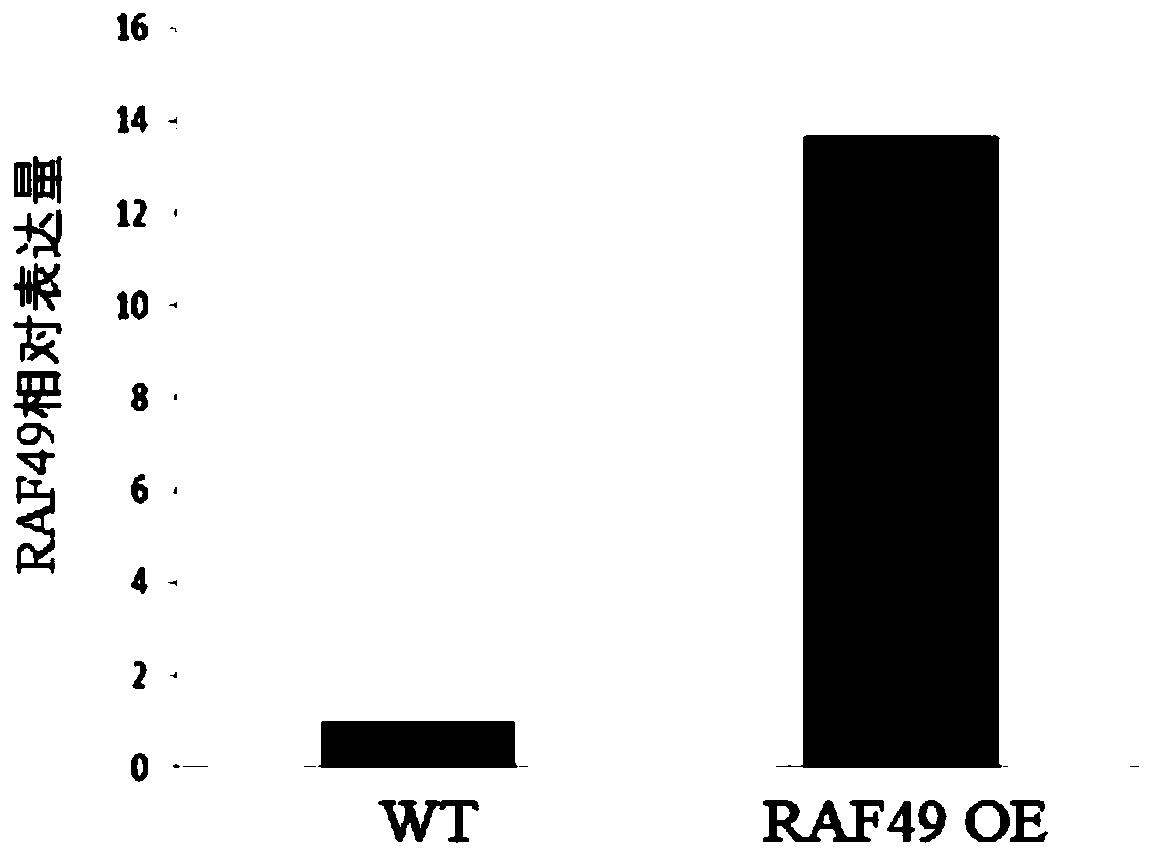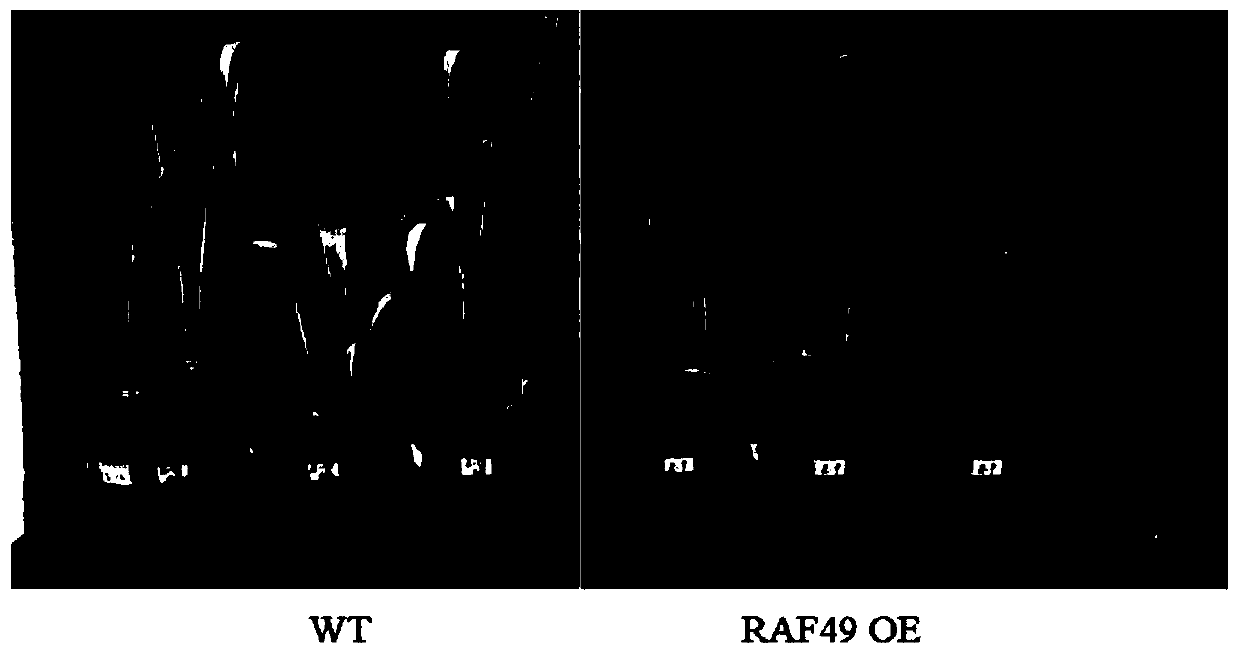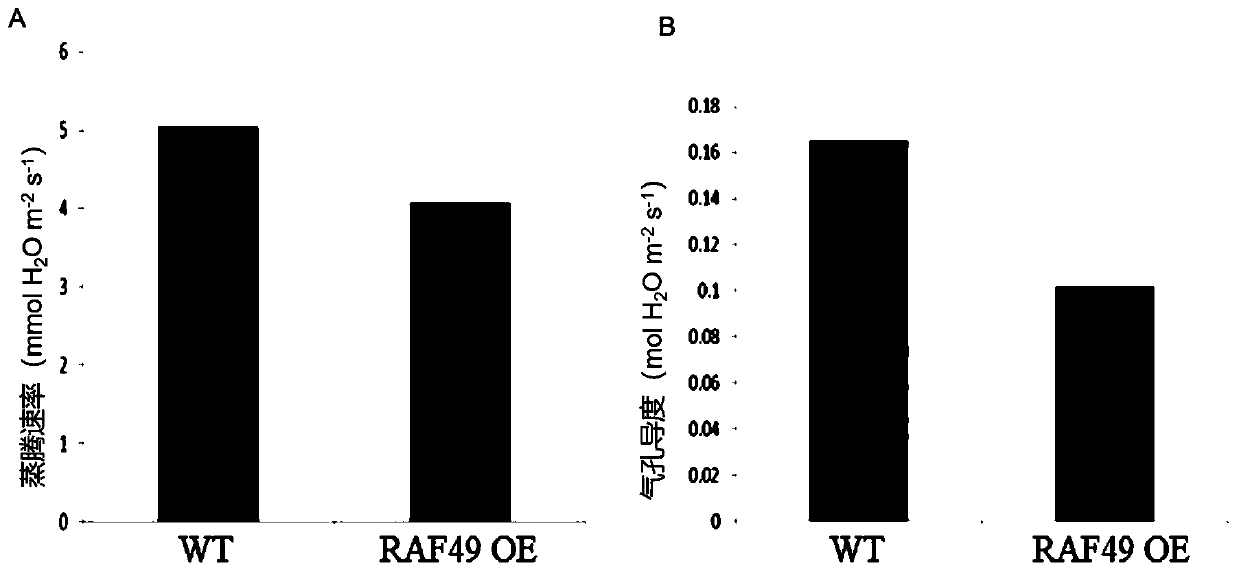Application of RAF49 protein and coding gene thereof in regulating and controlling drought resistance of plants
A technology of RAF49, 1.RAF49, applied in application, plant products, genetic engineering, etc., can solve problems such as accumulation of organic matter and decrease of seed setting rate, inhibition of crop nutrition and reproductive growth, impact on crop yield and quality, and improve breeding efficiency , shorten the breeding cycle, and reduce the degree of leaf wilting
- Summary
- Abstract
- Description
- Claims
- Application Information
AI Technical Summary
Problems solved by technology
Method used
Image
Examples
Embodiment 1
[0045] Example 1 Construction and detection of RAF49 gene overexpression vector
[0046] Extract total RNA from corn (Zea mays L.), reverse transcribe to obtain cDNA, use cDNA as a template, and F and R as primers to amplify the RAF49 gene. on the carrier. The specific construction method is as follows:
[0047] (1) The total RNA of corn was extracted with the RNA extraction kit of Magen Company, and the specific steps were referred to the instructions of the kit.
[0048] (2) Use the reverse transcription kit from Thermo Company to reverse transcribe the RNA into cDNA, and refer to the kit instructions for specific steps.
[0049] (3) Using cDNA as a template and F and R as primers, amplify the cDNA of RAF49 gene, run electrophoresis and cut the gel to recover the amplified product, and the recovery method refers to the kit of Tiangen Company.
[0050] The primer sequences used for RAF49 gene amplification are as follows:
[0051] SEQ ID NO.3: Upstream primer F: GCTCTAGAG...
Embodiment 2
[0056] SEQ ID NO. 6: NosR-seq: AGACCGGCAACAGGATTCAATC. Construction and detection of embodiment 2 RAF49 gene overexpression plant
[0057] The pBCXUN-RAF49 overexpression plasmid constructed in Example 1 was transformed into competent Agrobacterium strain EHA105 by heat shock method, and positive clones were identified by colony PCR. Inoculate a single colony of Agrobacterium correctly identified in 2-3 mL of liquid medium containing 100 μg / mL kanamycin and 50 μg / mL rifampicin, culture with shaking at 28 °C overnight, and transfer a large amount of liquid containing antibiotics the next day Shake culture in the medium, collect the cells after several transfers, and resuspend to OD 600 Between 0.8-1.0. The obtained recombinant Agrobacterium suspension was used to infect the immature corn embryos of B73 under aseptic conditions, and the callus was induced to form seedlings. The transgenic plants were self-propagated to obtain the T3 generation for subsequent experiments.
[...
Embodiment 3
[0059] Example 3 Phenotype Detection of RAF49 Gene Overexpression Maize Drought Treatment
[0060] The RAF49 gene overexpression maize line T3 generation that embodiment 2 constructs carries out drought treatment experiment, and specific method is as follows:
[0061] Add 140g of soil to each small pot, add water to the tray, put 4 seeds in each small pot, cover with 50ml of soil, pour out the remaining water in the tray after absorbing the water, and cultivate it in a greenhouse at 25°C. After emergence, it will grow Remove a seedling that is uneven, add 1L of water to the tray, pour out the water after it is full, and start drought treatment (continue to cultivate in a greenhouse at 25°C, no water will be given during the cultivation process), dry treatment for about a week, and observe wild plants. phenotypes such as growth and leaf wilting degree of transgenic plants under drought treatment. Three pots of wild-type and transgenic plants were used as biological replicates....
PUM
 Login to View More
Login to View More Abstract
Description
Claims
Application Information
 Login to View More
Login to View More - R&D
- Intellectual Property
- Life Sciences
- Materials
- Tech Scout
- Unparalleled Data Quality
- Higher Quality Content
- 60% Fewer Hallucinations
Browse by: Latest US Patents, China's latest patents, Technical Efficacy Thesaurus, Application Domain, Technology Topic, Popular Technical Reports.
© 2025 PatSnap. All rights reserved.Legal|Privacy policy|Modern Slavery Act Transparency Statement|Sitemap|About US| Contact US: help@patsnap.com



